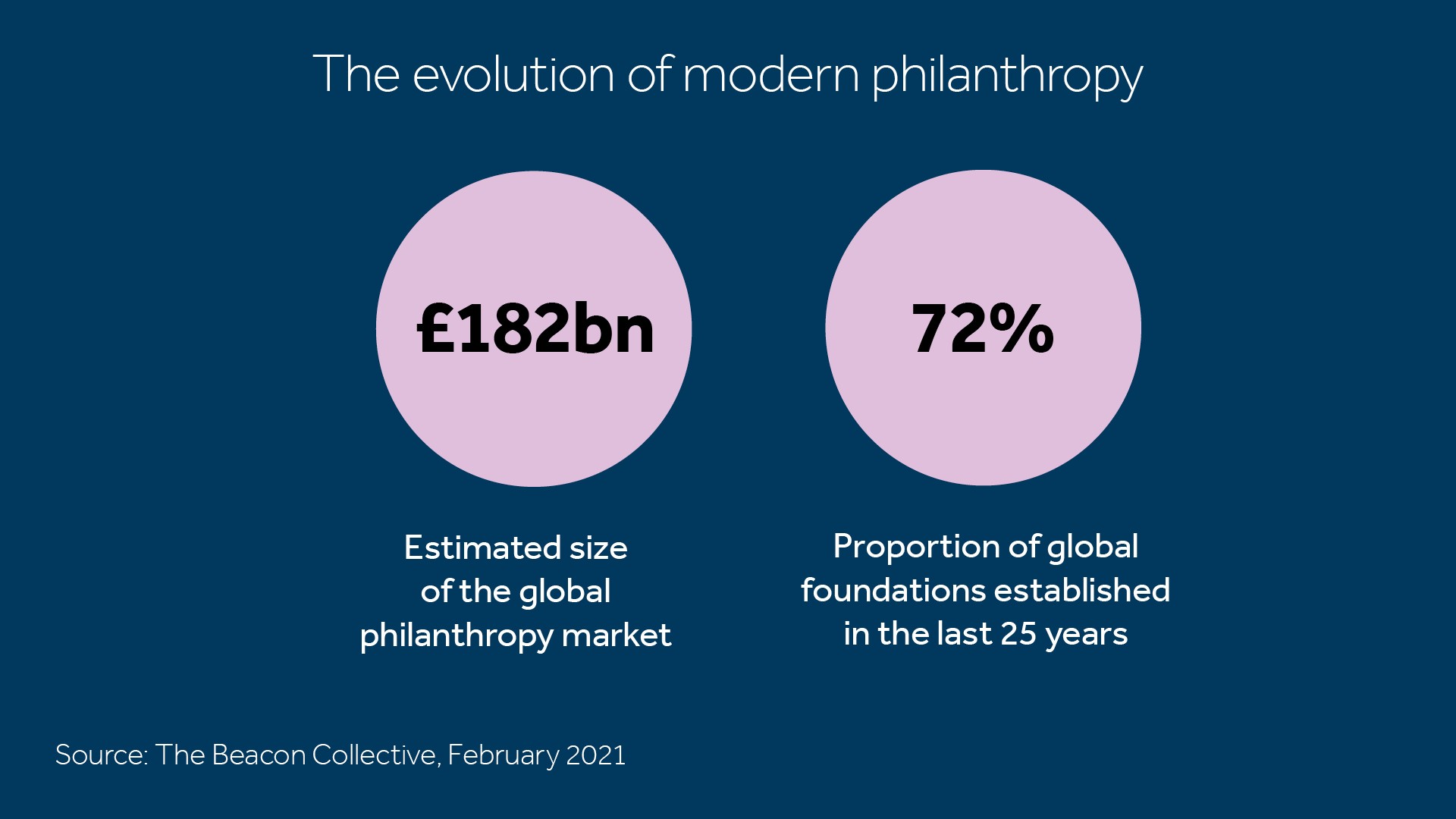
Philanthropy Outlook: Reflections on 2021 and a look ahead to 2022
06 December 2021
5 minute read
This article is written by Juliet Agnew, our Head of Philanthropy. It’s the first piece in a new four-part series exploring the role of philanthropy, the personal experiences of philanthropists, and the evolving global trends that are redefining the act of giving. You can access the other articles at the bottom of the page.
Philanthropy by its very nature exists at the intersection between private wealth and societal need, so is sensitive to societal shifts. The last few years have been witness to seemingly unprecedented global change and instability – from COVID-19 to political polarisation, to the racial justice and #metoo movements, as well as migration, the ubiquitous presence and influence of technology, and the widespread effects of climate change. These trends and forces have had profound and powerful effects on our daily lives, and they are also affecting and influencing the giving landscape.

In this article I highlight five trends that accelerated in 2021, and which are in my opinion, likely to continue into the year ahead:
1. More speed and more trust
During the peak COVID-19 trauma, funding was required quickly but some of the traditional sources were cruelly stifled. Demand surged for charity sector support while incomes from events, marathons and many planned fundraising initiatives tanked. It’s reported that 60% of charities saw a loss of income, and a 32% said they experienced a shortage of volunteers1.
Thankfully, many established donors with existing relationships and experience, responded by loosening restrictions and making decisions more quickly, so that frontline organisations could adapt and deploy assistance at pace.
This trend towards more trusting relationships is one that has been gaining traction for a few years. In parallel, across a number of fronts I’m seeing more partnership, more involvement of beneficiaries and grassroots organisations in funding decision-making, and more focus on local communities being in the driving seat. The result is the co-creating of solutions, rather than top-down, isolated decision-making.
2. Equity into actionable plans
The racial justice movement has brought into the spotlight just how “colour blind” philanthropy has historically been. More and more UK and global foundations have committed publically to addressing structural and systemic racism in the UK, identifying and naming how philanthropy has contributed to such inequities. Diversity and inclusion are now high on the agenda, as foundations are increasingly being judged on the action plans they have in place for trustees and staff. Their commitment to, and accountability for addressing systemic racism and female empowerment, also face greater scrutiny. Put simply, words alone are no longer enough.
3. Giving while living
Giving while living is increasingly popular as more donors enjoy seeing results of their generosity in their lifetime. Widespread coverage of high profile philanthropists and their ventures, as well as initiatives like the Giving Pledge and Forbes’ focus on actualised giving, have no doubt inspired billionaires to give sooner and more ambitiously, in light of some of the urgent issues of our times. But giving while living is not just for billionaires.
This trend is also driven by increasing numbers of successful entrepreneurs-turned-philanthropists who want to do more than give money, but also deploy their skills, time and connections to make a difference sooner rather than later. Families are also seeing philanthropy as an opportunity for parents and children to work alongside each other on initiatives with purpose and impact. The chance to build a legacy whilst handing down values, skills and responsibility during their lifetime, is one more people are keen to embrace.
4. Systemic change and collaboration
As the philanthropic landscape has developed and the complex nature of social environment issues become increasingly clear, more funders are alive to the fact that no single donor has the resources, reach, knowledge or influence to move the needle on our most intractable global problems on their own. Bringing others on the journey with you is therefore now essential if your philanthropic vision is ambitious and seeks to solve root causes.
There are many benefits of collaboration, too – not just the opportunity to leverage peer resources, skills and expertise - including:
- sharing of risks and pooling costs;
- streamlining funding into targeted interventions to make it simpler for grantees;
- the opportunity to act as thinking partners on what is often a long and complex journey towards change.
More donors are signing up to this approach from the get-go, and there has been a resultant rise in philanthropy networks and group giving as a result. Whilst more time-consuming, the positive effects can far outweigh downsides.
5. New Models
Before the pandemic, philanthropy had been steadily evolving as donors shift from traditional giving of money away, to new ways of working: greater use of digital tools and data to inform decision-making, the blending of mindful investment choices alongside giving to enhance mission alignment, and deploying all assets (and not just a few) towards achieving philanthropic goals.
Many of these shifts have been driven, as mentioned, by entrepreneurs bringing commercial mind-sets into their philanthropy, but they are also being driven by younger philanthropists. Broadly speaking, next generation givers are vocal about wanting to act with a social conscience and are more likely to disrupt traditional philanthropy by integrating social purpose across broad areas of their life – from investment to spending choices, as well as donations.
New year, new goals?
Philanthropy does not exist in a vacuum, yet historically this field has been notoriously insulated from change. In light of recent events, this is now not the case, and philanthropy finds itself at a critical juncture. On the one hand, philanthropy has never been so effective and so ambitious; on the other hand, there is more intense scrutiny on sources of wealth and the freedoms donors have to direct philanthropy in ways of their choosing. All of this has led to increasing requirements for accountability.
In an environment where tangible impact requires you to work with others, credibility has never been so important. It may just be that those funders who adapt their practices to align with these monumental societal shifts, are the ones that succeed and thrive; whereas others will be rendered obsolete.
The good news is that there has never been a better time to give back. High quality guidance and examples exist, and smart philanthropy deployed now and with good intention, has the opportunity to make a real impact on society’s most pressing issues.
I’m personally very excited to see the role philanthropy plays next year and longer term in the post-pandemic era. In the meantime, I hope you enjoy reading the other articles in this series.
Related articles
This communication is general in nature and provided for information/educational purposes only. It does not take into account any specific investment objectives, the financial situation or particular needs of any particular person. It not intended for distribution, publication, or use in any jurisdiction where such distribution, publication, or use would be unlawful, nor is it aimed at any person or entity to whom it would be unlawful for them to access.
This communication has been prepared by Barclays Private Bank (Barclays) and references to Barclays includes any entity within the Barclays group of companies.
The communication is:
- not research nor a product of the Barclays Research department. Any views expressed in these materials may differ from those of the Barclays Research department. All opinions and estimates are given as of the date of the materials and are subject to change. Barclays is not obliged to inform recipients of these materials of any change to such opinions or estimates;
- not an offer, an invitation or a recommendation to enter into any product or service and do not constitute a solicitation to buy or sell securities, investment advice or a personal recommendation;
- is confidential and no part may be reproduced, distributed or transmitted without the prior written permission of Barclays; and
- has not been reviewed or approved by any regulatory authority.
Any past or simulated past performance including back-testing, modelling or scenario analysis, or future projections contained in this communication is no indication as to future performance. No representation is made as to the accuracy of the assumptions made in this communication, or completeness of, any modelling, scenario analysis or back-testing. The value of any investment may also fluctuate as a result of market changes.
Where information in this communication has been obtained from third party sources, we believe those sources to be reliable but we do not guarantee the information’s accuracy and you should note that it may be incomplete or condensed.
Neither Barclays nor any of its directors, officers, employees, representatives or agents, accepts any liability whatsoever for any direct, indirect or consequential losses (in contract, tort or otherwise) arising from the use of this communication or its contents or reliance on the information contained herein, except to the extent this would be prohibited by law or regulation.